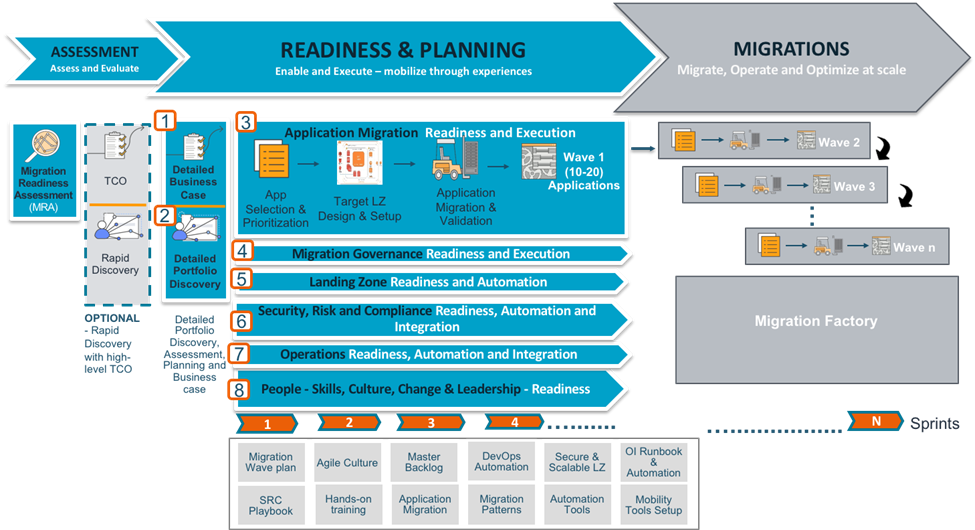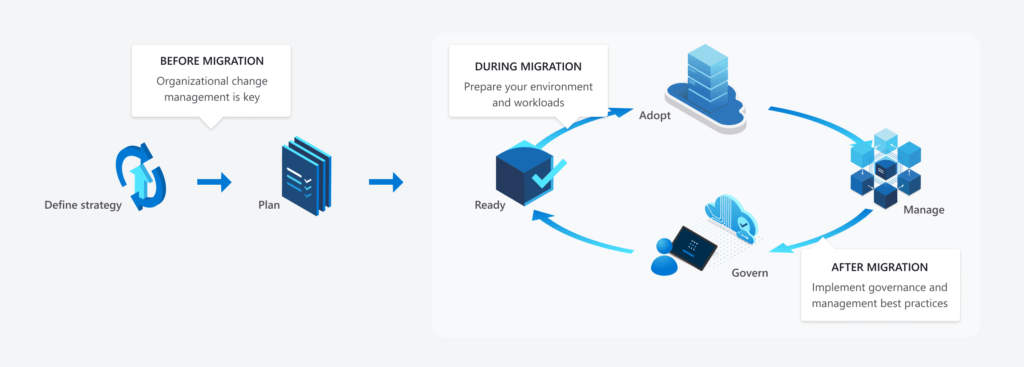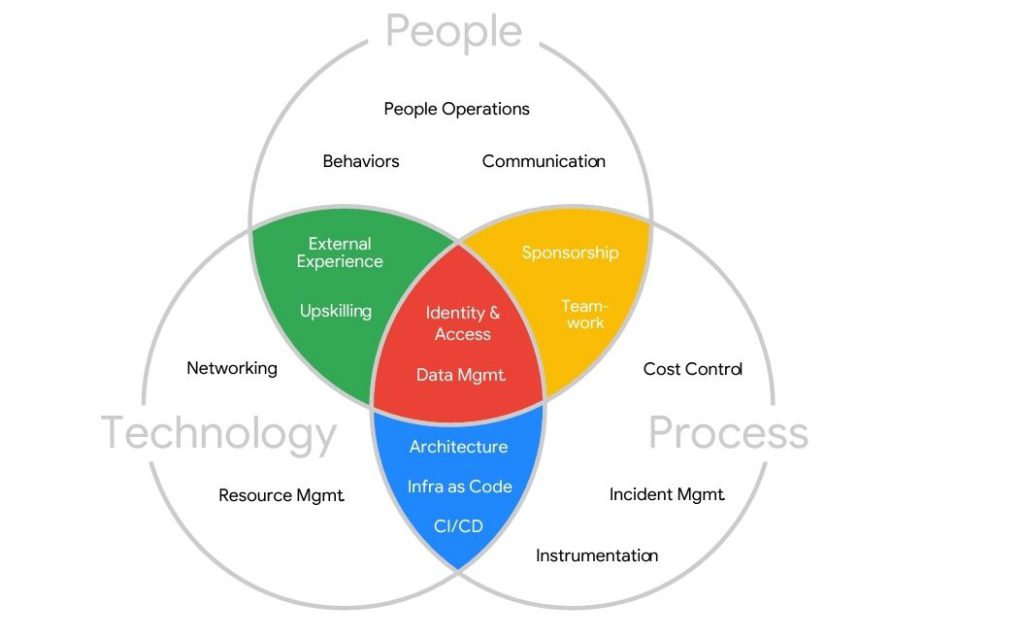When it comes to cloud migration or adoption, often organizations get into the practice of building a cloud migration framework before the migration. While having a cloud migration strategy is essential for successful cloud migration, it does not necessitate to build your own cloud migration framework.
During the assessment or discovery phase itself, you can start leveraging the below frameworks based upon your cloud vendor selection:
AWS Cloud Adoption Framework
Key highlights of the framework (Click Here to read more on AWS website):
#1 – Uses Perspectives to provide focus areas for managing different work streams
#2 – Provides Guidance on Applying 6’R Migration Strategy

#3 – Provides strategy on large-scale planning to accelerate cloud deployment
Read more details about large-scale migration by clicking here.

#4 – Provides Architecture Best Practices for Evaluation
AWS recommends to leverage their AWS Well-Architected Framework to assess & evaluate design decisions made throughout the cloud adoption journey. Read more about framework by clicking here.
It is centered around five pillars of architecture – Operational Excellence, Security, Reliability, Performance Efficiency & Cost Optimization.
Microsoft Cloud Adoption Framework
Key highlights of the framework (Click here to read more on Microsoft’s website):
#1 – Defines Cloud Migration Journey as 6 Stages
Click here for Infographics of 6 stages using Azure.
#2 – Provides Application Migration Strategy
It groups application migration approach into 5 R’s – Rehost, Refactor, Rearchitect, Rebuild & Replace. Click here to read more.
#3 – Provides Microsoft Assessment Tools to Keep Track of Journey
Click here to access Azure assessment tools, which includes:
- Azure Well-Architected Review – Provides assessment tool for each focus area: Cost Optimization, Operational Excellence, Performance Efficiency, Reliability, Security.
- Cloud Journey Tracker: Self-guided tool for tracking your journey and navigate to right area of the framework.
- Developer Velocity – Run an assessment to figure out Developer Velocity Index (DVI) score for your organization for efficiency.
- Governance Benchmark – Gap analysis for current and future state of governance.
- Strategic Migration Assessment and Readiness Tool – For measuring cloud migration readiness assessment.
#4 – Best practices categorized for each stage
The framework documentation is detailed and will highly recommend to read following areas:
- Click here for best practices for Plan
- Click here for best practices for Ready
- Click here for best practices for Adopt
- Click here for Governance considerations
- Click here for best practices for Manage
Google Cloud Adoption Framework
Key highlights of the framework (Click here to read more on Google’s website):
#1 – Uses four themes for Cloud Maturity Assessment
Google recommends using four themes = Learn, Lead, Scale & Secure to develop cloud-ready organization. For each theme, they divide practices into three buckets – Tactical, Strategic & Transformational.
#2 – Defines Epics based on Cloud Adoption Themes
For lean implementation, you can focus on the epics inside the four cloud adoption themes and for an enterprise, all eighteen epics can be explored, which are:
- Access management – ensuring authorization for people & services based on actions permitted
- Architecture – for best practices and recommendations for cloud architecture
- Behaviors – for building the right team and enculating the behavior required for successful cloud migration
- Continuous integration and delivery (CI/CD) – for automating changes to the system through a CI/CD process pipeline with minimal human intervention
- Cost control – for building cost consciousness for cloud resources at each layer including architects & developers and maximizing visibility into the costs incurred in near real-time
- Communication – for building the open culture and encourage team to learn from mistakes for future opportunities
- Data management – for understanding and managing data storage, data origination, data security, data access, etc.
- External experience – for accelerating cloud adoption by applying best practices and other organizational lessons learned since start
- Identity management – for authentication of users and services and establishing security guardrails
- Incident management – for alerting, triaging, and rectifying unplanned outage or degradation in timely manner
- Infrastructure as code – for automating infrastructure configuration and provisioning of cloud resources
- Instrumentation – for measuring cloud services health and logging events to ensure service-level objectives are measured and tracked
- Networking – for network connectivity and services protection and managing data flow across systems
- People operations- for defining the required organization structures with people’s role, skills, and performance alignment
- Resource management – for organizing, naming, and managing quotas of cloud resources in order to ensure a structured, consistent, and controlled environment
- Sponsorship – for executive support for cloud migration/adoption journey
- Teamwork – for team building with culture supporting cloud migration/adoption
- Upskilling – for preparing people for the right cloud skill-set
#3 – Approach on establishing Cloud Center of Excellence
Click here to read the whitepaper on building Cloud CoE.
#4 – Tools for Cloud Migration
- Cloud Maturity Assessment – Click here to do access tool and plan & measure cloud migration approach
In summary, all three cloud adoption frameworks are very well documented and provides a detailed approach for cloud migration/adoption for any organization. Hence, there is no need to reinvent the wheel and develop your own framework – you can leverage any one of them based on your suitability.
References:
- AWS Cloud Adoption Framework – https://azure.microsoft.com/en-us/cloud-adoption-framework/
- Microsoft’s Cloud Adoption for Azure – https://azure.microsoft.com/en-us/cloud-adoption-framework/
- Google’s Cloud Adoption Framework – https://cloud.google.com/adoption-framework
- Software Architecture Blog Post https://vedcraft.com/architecture/5-reports-every-software-architect-should-read/
- Slide’s Layout Courtesy – https://slidesgo.com/





